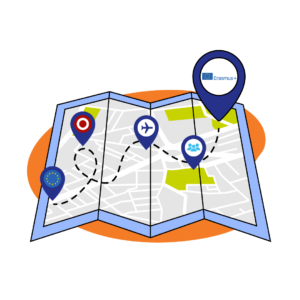Watch the short videos to learn more about the Erasmus+ programme

Erasmus+ KA1, also known as Key Action 1, provides opportunities for schools and educational organizations to participate in international projects and exchanges. The main goal of KA1 is to promote cooperation, learning, and mobility among students and staff members.
Here’s how it works:
The Key Action 1 encourages the mobility of students, teachers, and other staff members. This means that people from one school can travel to another country and stay there for a certain period of time, usually a few weeks or months. During their stay, they can attend classes, engage in workshops, or take part in various educational activities.
The participants get a chance to learn about different cultures, languages, and educational systems. They can share their own experiences and knowledge with others. This helps in broadening their perspectives and gaining new skills.
Erasmus+ KA1 provides financial support for the mobility activities. This funding covers travel costs, accommodation, and a part of the daily expenses. It makes it easier for schools to participate in international projects without putting a heavy burden on their budgets.
Overall, Erasmus+ KA1 encourages schools to collaborate, learn from each other, and experience different cultures through student and staff mobility. It promotes international understanding and cooperation while providing financial support for these educational opportunities.
Erasmus+ KA2, also known as Key Action 2, supports cooperation and innovation in the field of education. It allows schools and educational organizations to work together on projects that aim to improve teaching methods, develop new educational materials, and enhance the quality of education in general.
Here’s how it works:
Schools or educational institutions from different countries form partnerships or groups to collaborate on specific projects. These projects can focus on a wide range of topics, such as digital skills, inclusive education, environmental sustainability, or creativity (see the priorities of Erasmus+),
Project Development: The participating schools work together to develop innovative and impactful projects. They identify common challenges in education and come up with creative solutions. This can involve creating new teaching materials, designing educational activities, or implementing new approaches to learning.
Implementation and Testing: Once the project is developed, the schools implement and test their ideas in real educational settings. They try out the new teaching methods or materials and gather feedback from students and teachers. This helps in refining and improving the project outcomes.
Dissemination and Sharing: The schools share their project outcomes, experiences, and best practices with other schools and educational organizations. They may organize conferences, workshops, or online platforms to showcase their work. This sharing of knowledge and expertise contributes to the overall improvement of education across Europe.
Erasmus+ KA2 provides financial support for the project activities. This funding covers project management costs, staff training, travel expenses, and other related expenses. It helps schools implement innovative projects without straining their budgets.
Overall, Erasmus+ KA2 is a program that encourages schools to collaborate, develop innovative projects, and share their knowledge and experiences with other educational institutions. It supports the improvement of education by promoting cooperation, innovation, and the exchange of best practices.

The European Commission’s support for the production of this website and its content does not constitute an endorsement of the contents, which reflect the views only of the authors, and the Commission cannot be held responsible for any use which may be made of the information contained therein. [Project nr. 2020-1-SE01-KA201-077822]
©SERN 2023